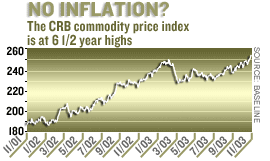NEW YORK (CNN/Money) -
The Federal Reserve sees so little inflation in the economy that it's more worried about an "unwelcome fall" in inflation than an unwelcome rise.
Take a look at what's going on with prices, and you might wonder where the Fed is getting its information.
To start with, commodity prices from soybeans to cotton to grade A broilers have been running higher this year -- a factor in Friday's surprising rise in the producer price index, which measures inflation at the wholesale level.
“ The CPI is correct in measuring consumer prices. But it's not correct in measuring the cost of living. ”
Tony Creszenzi
Miller Tabak
|
The Commodity Research Board's index of commodity prices touched a new 6-1/2 year high Thursday. The industrial materials index administered by the Journal of Commerce and the Economic Cycle Research Institute is rising at a 33.7 percent annual clip.
"The basic message is unambiguous -- you've got inflation," said Lakshman Achuthan, managing director of the Economic Cycle Research Institute.
Nor is it just wholesale prices that are moving higher. Take a look in the guts of the nation's key reading on inflation -- the consumer price index -- and you'll find that many of a typical household's big expenditures have risen markedly over the past year.
From September of last year to September this year the cost of education, according to the CPI data, has risen 7 percent. Medical costs are up 4 percent, utilities are up 8.6 percent. All of these much higher than the overall CPI, which grew at just a 2.3 percent rate, and the "core" CPI, which excludes food and energy prices because they're so volatile, and which grew just 1.2 percent.
"The things that make up the bulk of consumer expenditures for most U.S. households -- all of them seem to be moving up significantly," said Carlos Asilis, portfolio manager with the hedge fund Vega Asset Management.
So what's keeping the reading on inflation low? Asilis thinks one big piece of the picture is housing. In computing the CPI, the Bureau of Labor Statistics assigns a 22.2 percent weighting -- the most of any item -- to something called "owners' equivalent rent of primary residence." Basically, it's an estimate of what homeowners might pay in rent if they rented their homes instead of owning them.
To calculate this, the BLS looks at actual rents, compares them to owned residences and then uses that to calculate housing costs.

The problem? The low-interest rate environment has meant that many people who might otherwise rent now own -- in fact, home ownership rates are at record highs. As a result, rents have come under pressure, and "owners' equivalent rent" has grown at just 2.1 percent over the past year -- less than the overall CPI and far lower than the costs for education, health care and so on.
You can catch the circularity here. Because the inflation reading is low, rates are low, which has upped home ownership, which has pressured rents, which has put a cap on "owners' equivalent rent," which has helped keep the inflation reading low. Etc.
Another big chunk -- 8.2 percent -- of the CPI is new and used motor vehicles. Over the past year vehicle prices have fallen 3.6 percent, thanks to tough competition. Part of that is due, again, to a kind interest-rate environment. Although zero-percent financing doesn't factor directly into the box score the way the BLS calculates inflation, it has brought the cost of buying down, prompting many consumers to trade in their almost-new car for a brand new one.
"What you're seeing is a glut of gently used vehicles, and that's putting pressure on all vehicle prices," Lehman Brothers economist Joe Abate said.
Could higher rates force car prices higher? It could certainly raise the cost of buying a car, since those generous financing deals would go away, and that might make used vehicles more attractive, lifting their prices. But competing with this, auto companies are intensely interested in selling everybody a new set of wheels, and the industry remains awash in excess capacity.
Maybe more important, buying a new car simply doesn't constitute a regular expense like tuition, paying for electricity or putting gasoline into that car. (And some expenses don't even factor into the CPI -- like the trend of companies shifting a portion of benefit costs to employees.)
"The CPI is correct in measuring consumer prices," said Miller Tabak bond market strategist Tony Crescenzi. "But it's not correct in measuring the cost of living."
Some economists believe that prices for services, like health care, won't increase over the coming months as fast as they have over the past year, and this will put downward pressure on the CPI.
Bond investors aren't so sure. They have been steadily buying Treasury inflation-protected securities, or TIPS, the returns on which rise and fall with inflation. As a result, the spread on the yield between 10-year TIPs and 10-year Treasurys has grown to 2.38 percent -- the widest difference since 2000.
Putting it another way, even though 10-year Treasury yields haven't risen as much as some analysts might expect, it's been three years since the bond market has been so worried about the prospect of inflation.

|

